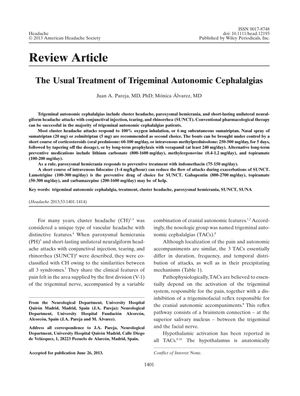The Usual Treatment of Trigeminal Autonomic Cephalalgias
October 2013
in “
Headache: The Journal of Head and Face Pain
”

TLDR The document concludes that inhalation of oxygen and sumatriptan injections are primary for cluster headaches, indomethacin for paroxysmal hemicrania, and lidocaine and lamotrigine for SUNCT, but SUNCT often resists treatment.
The document from 2013 reviews the treatment options for trigeminal autonomic cephalalgias (TACs), focusing on cluster headaches, paroxysmal hemicrania, and SUNCT. For cluster headaches, inhalation of 100% oxygen or a 6 mg subcutaneous injection of sumatriptan is the primary response treatment, with corticosteroids for short-term control and verapamil, lithium carbonate, methylergonovine, and topiramate for long-term prophylaxis. Paroxysmal hemicrania is typically treated with indomethacin. SUNCT treatment may involve a short course of intravenous lidocaine and lamotrigine as the preventive drug of choice, with gabapentin, topiramate, and carbamazepine as alternatives. The document highlights the difficulty in treating SUNCT, noting that while some patients respond to lamotrigine at doses of 100-300 mg/day, the condition often remains refractory to conventional therapy, sometimes necessitating more invasive methods. The authors, Juan A. Pareja and Mónica Álvarez, contributed to the conception, design, data acquisition, and manuscript preparation of the document.
